It’s no secret that when Subaru and Toyota collaborated to develop and manufacture electric vehicles, the resulting first products, the Solterra and bZ4X were, to put it bluntly, underwhelming. Relative to the competition, the styling wasn’t loved, the range was short, charging was slow and they were pricey. Now three years later, they have responded in exactly the right way – don’t make excuses, just move on, fix virtually everything that was wrong and explain what you did. Back in May I had a chance to take a brief drive around Plano Texas in the 2026 Toyota bZ and now we’ve had a chance to spend a full day in much more varied surroundings with the updated Solterra.
At this point, three years into a vehicle’s life, it’s pretty typical to do a mid-cycle refresh. This typically involves some new colors, wheels, a reworked grille and lights and not a whole lot else. When we saw the 2026 Solterra at the New York Auto Show in April, at first glance that’s what it looked like we were getting. But the reality is actually so much more. In fact, apart from the sheetmetal skin, almost everything else of consequence has changed. The key across the board has been attention to detail.
More Than Just A Facelift
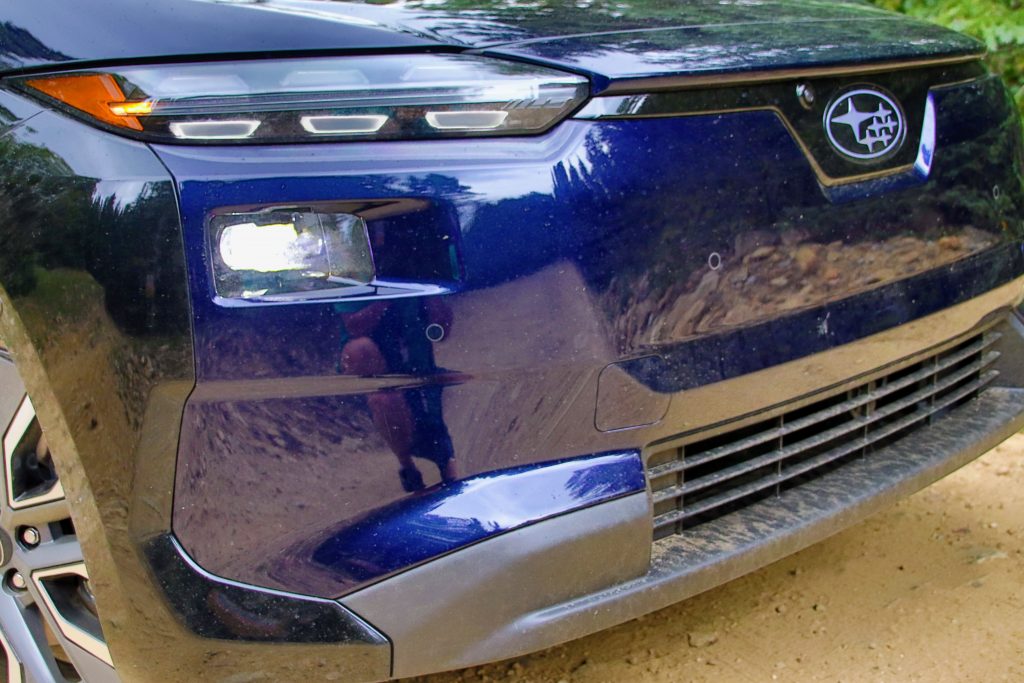
One of the most obvious complaints about the Solterra was its somewhat busy and frankly a bit incoherent design. It is like so many other vehicles today, a “compact” crossover competing with EVs like the Volkswagen ID4, Ford Mustang Mach-E and Tesla Model Y. But it is also a competitor to the Toyota Rav4, Honda CR-V and of course Subaru’s own Forester. Compact is of course a relative term in 2025, as almost everything but a Miata continues to grow with succeeding generations.
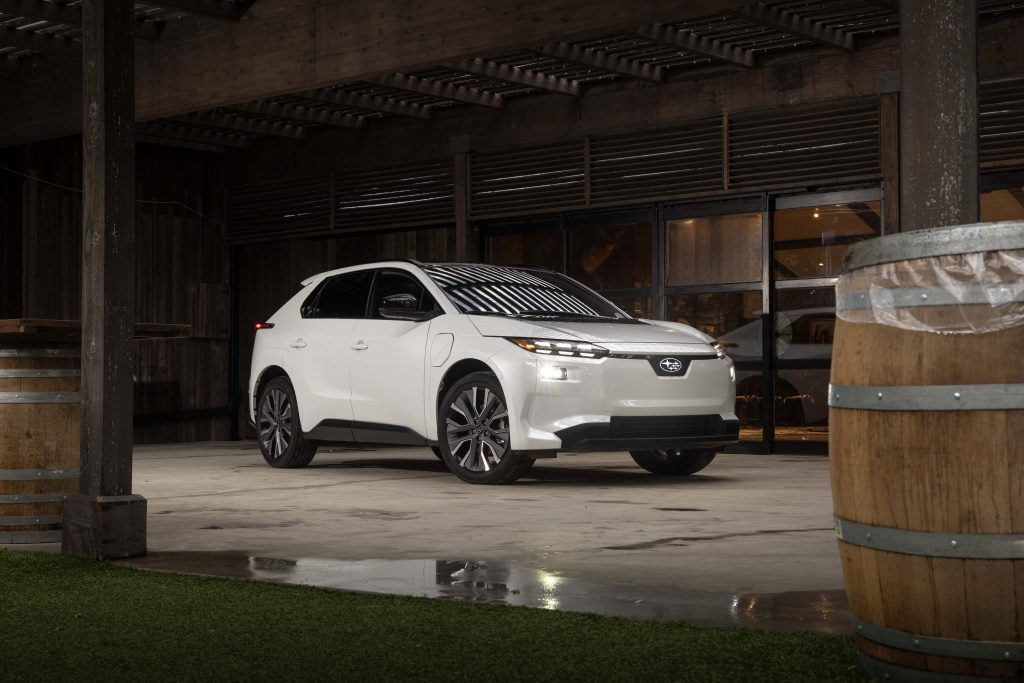
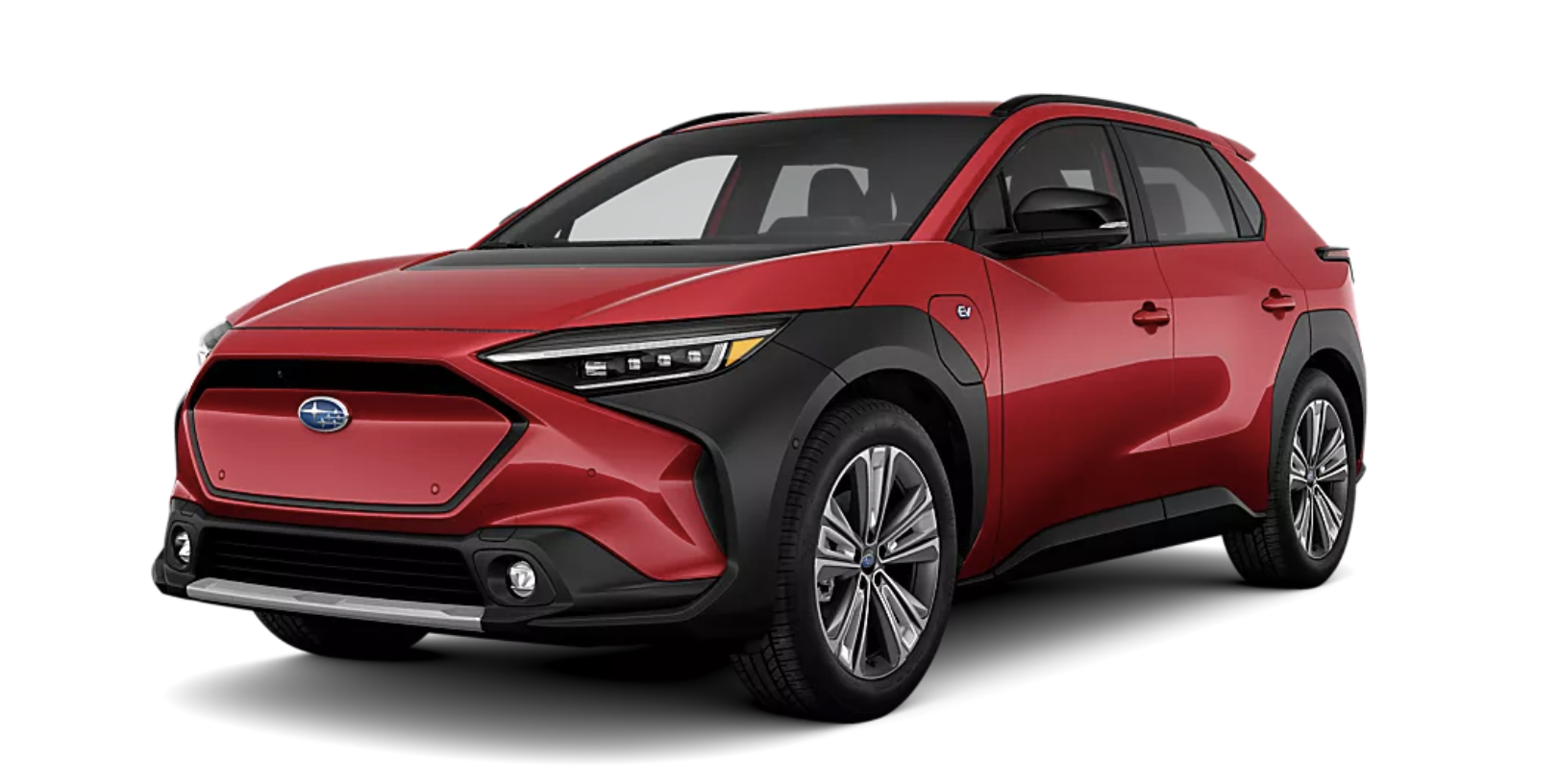
The two biggest design offenses were the front fascia and the black wheel arches, both of which are addressed to some degree. Starting with the 2026 model year, new Subarus are getting a different approach to the front lighting. There is a six element daytime running light arrangement with two horizontal rows of three elements on each corner. The six elements represent the six stars in the brand logo, which itself is derived from the Pleiades star cluster (which is what Subaru means in Japanese). Astronomy fans will of course note that there are indeed five stars in Pleiades. The sixth represents the company which was formed from the merger of five other brands. The new Outback, plus the upcoming Trailseeker and Uncharted, have all adopted this look, and I think it’s a definite improvement.
The overall busyness of the design was exacerbated by those contrasting black wheel arches. The car shown in New York was white with white painted arches which looked much cleaner. Unfortunately, the body colored arches are only available for customers who select white, silver or black for the sheetmetal paint. The other colors, mist gray pearl, elemental white and the new midnight tide mica retain the black arches. We drove the mica which is a dark blue that in many instances looks almost black so the fenders don’t stand out that much anyway.
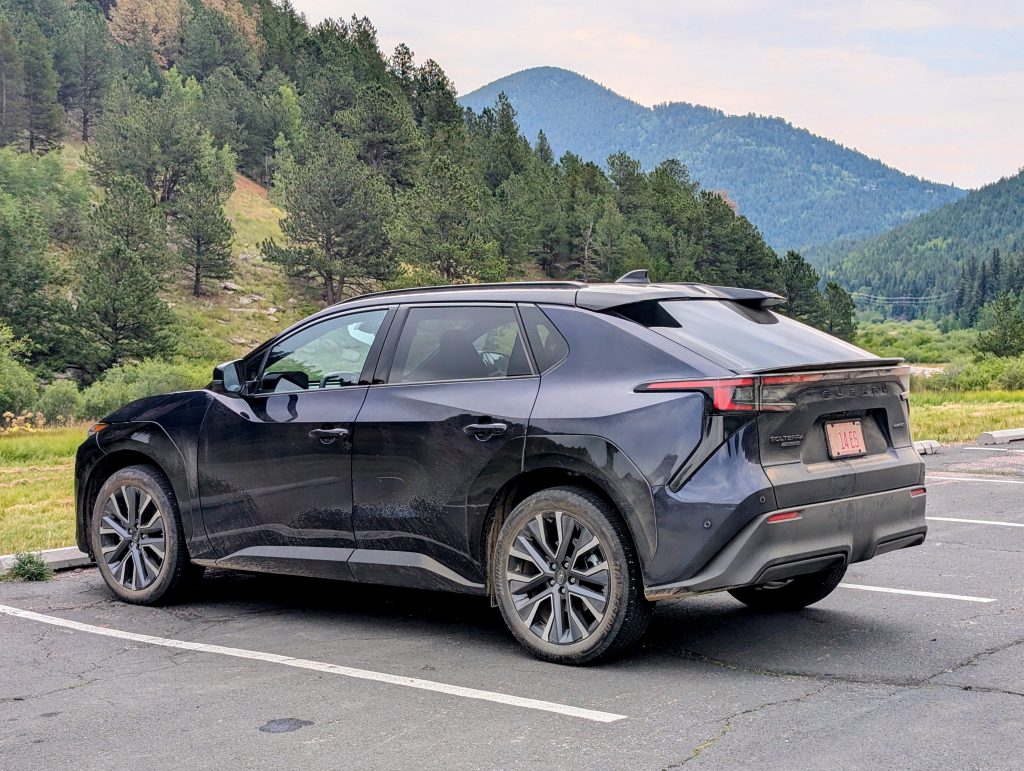
According to Subaru, this was done for logistical reasons in the assembly plant because the company evidently didn’t have space to store so many unique colors of the wheel arches. Perhaps we’ll see the option expand to other colors in future model years.
The aero extensions at the top of the tailgate and the mirror housings have also been re-contoured, although those changes are fairly modest. The goal here, along with the front end changes, was to reduce drag and improve efficiency. With the mirrors, there was also a desire to reduce wind noise; this was successful, I found.
Reenergizing The Battery
The final exterior change of note was the positioning of the charging port, which like the bZ has gone from the left front fender to the right. That’s because the car has ditched the CCS1 port for an SAE J3400/NACS charging port.
Placing the port on the right front fender allows Solterra drivers to nose into Tesla Supercharger bays and reach the port with the exceptionally short cables used on V3 Superchargers. We didn’t get to do any charging during our day with the Solterra, but it does include Plug&Charge support so you won’t have to use a Tesla or Subaru app to pay for charging, just put your payment method into your Subaru account in advance and you’re good to go.
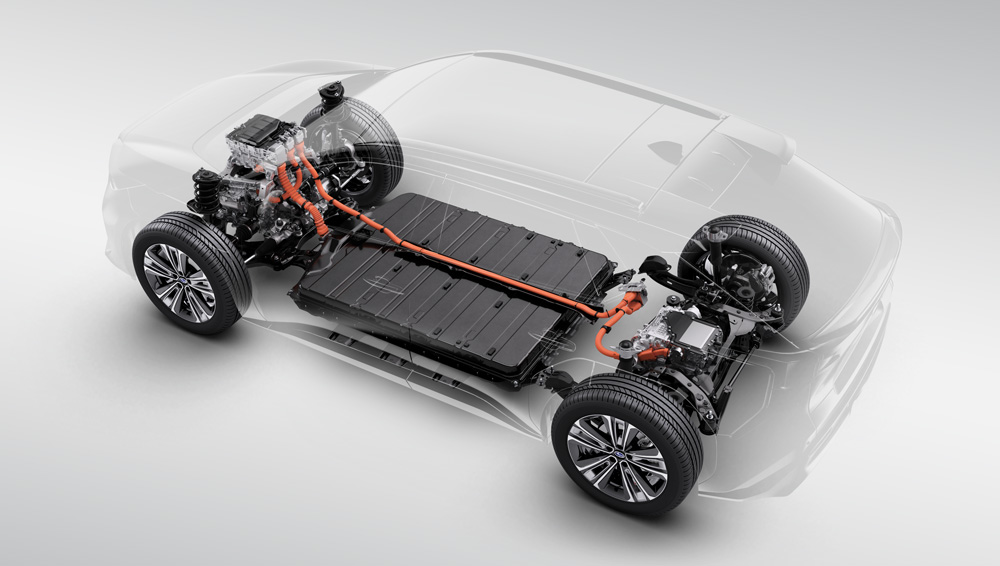
As long as we’re talking charging, that was one of the biggest complaints with the Solterra/bZ4X. For an EV that was brand new in 2022, the charging was abysmally slow, peaking at just 100-kW on a DC fast charger and dropping off very rapidly after that peak. It could take 56 minutes to get to 80% charge and well over an hour to get a full charge on a battery that was just 72.8-kWh. While Subaru and Toyota updated the software after launch to improve the charging curve so it didn’t ramp down as aggressively, it was still significantly slower than competitors.
Among the many changes for 2026 are a new on-board charger, new power electronics, updated battery management system and more. In particular, the thermal management system now includes pre-conditioning, which can be enabled automatically when a DC charger is set as the navigation destination or manually. DC fast charging now peaks at 150-kW for the 400V architecture and getting from 10% to 80% now only takes 30 minutes. It’s not as fast as the 800V vehicles on the Hyundai Motor Group e-GMP architecture, but will match most other competing vehicles. Subaru claims that with the preconditioning, charging performance is now essentially unchanged down to ambient temperatures of just 14 degrees F and up to 70 degrees.
AC charging has also been improved with maximum power being bumped from 7 to 11-kW making it easier to get a full charge overnight when the battery has been drained. The engineers did some repackaging of the battery so that even though the cell chemistry is unchanged, they managed to squeeze in more cells to bump the capacity to 74.7-kWh. Like Toyota, Hyundai and Kia on EVs with a NACS port, Subaru is bundling CCS1 to NACS and J1772 to NACS adapters so you can continue to use existing public and home charging infrastructure.
Improving…Everything
If you haven’t already done the math, the battery capacity has only gone up by 2.6%. However, the range has improved by 26%! The good part of that is that batteries are expensive, so getting that much increase didn’t cost a lot in terms of extra battery. So where did all that range come from?
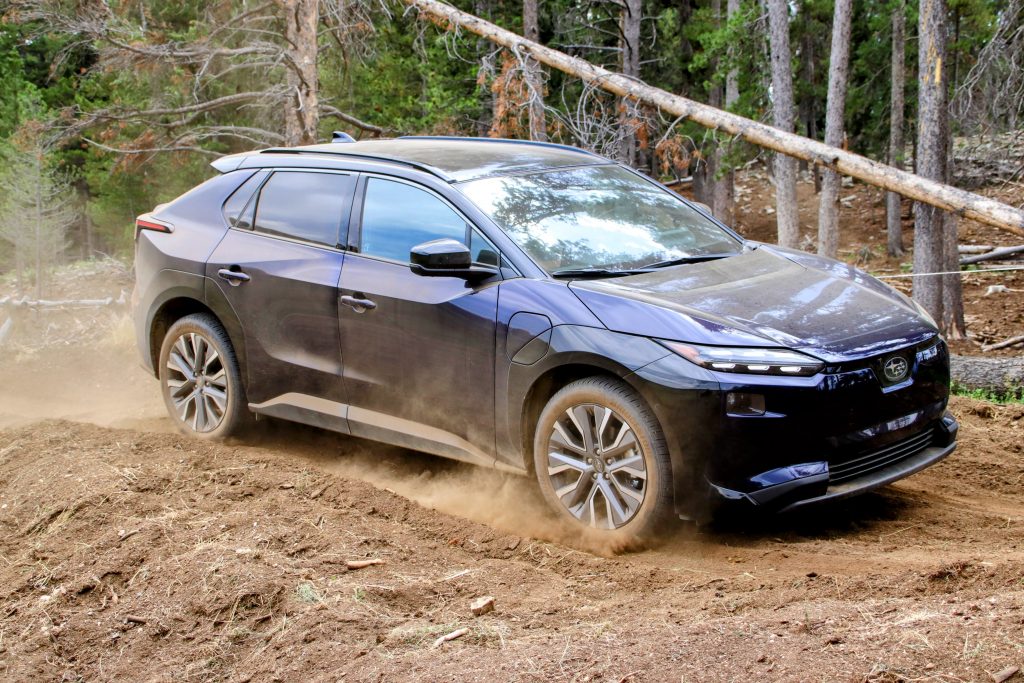
It’s the attention to detail. I’ve already discussed the aerodynamic tweaks, but mechanical drag also has a huge impact on EV efficiency and range. For example, the 2026 Solterra has all-new wheel bearings in the hubs that Subaru says reduce rolling drag by 18%. That’s less work for the motors to do to get the car moving and as with aero drag it allows more kinetic energy to be recaptured during deceleration.
Moving inboard from the wheels are the gears. This is part of a complete redesign of the propulsion system. Most EVs including the Solterra don’t have multi-speed transmissions but they do have a reduction gear set and a differential. The motor case for both the front and rear axles has been redesigned and is smaller and lighter. The gear arrangement has been revamped to change the ratio and place the gears themselves within the cooling oil for the motor to reduce friction. The gear teeth themselves have also been revamped and now have a polished finish, again contributing to reduced friction. Putting the gears in the oil also means the new electric oil pump doesn’t have to work as hard, reducing the parasitic load on the battery.
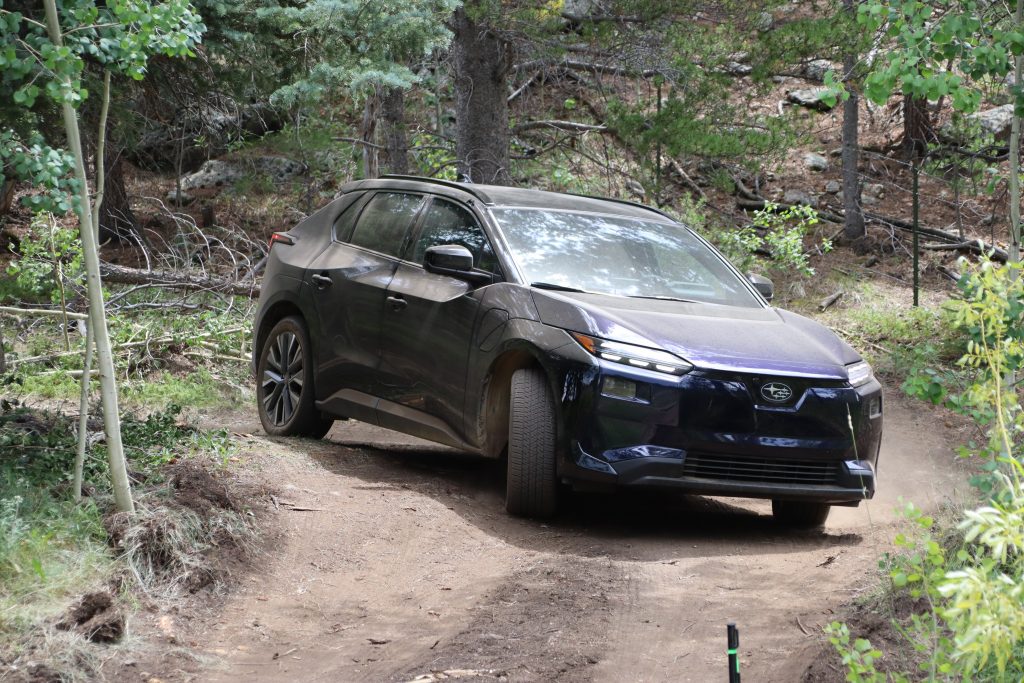
Both motors on the Solterra are of the permanent magnet type. The magnets have been repositioned within the rotor so that they now have an improved electromagnetic flux pattern. This in turn allows the rotor and the stator to be smaller and lighter while also producing more power and with greater efficiency. The Solterra and the other upcoming EVs from Subaru get a notable improvement in performance for 2026. Unlike the Toyota, all Solterras get all-wheel-drive and two motors. The base trim, inexplicably badges as Premium gets two 87-kW motors for 233-hp. The Limited XT and Touring XT get a front motor with nearly double that output and a total of 338-hp.
The inverter that handles the DC to AC and AC to DC conversion between the motor and battery has also been relocated and is integrated into the motor housing making vehicle assembly easier and reducing high voltage wiring. Finally, the inverter now uses silicon carbide switches rather than the previous silicon which allows for – you guessed it – more efficient power conversion.
Each of these changes by themselves might improve the overall energy efficiency by anywhere from a fraction of a percent to a few percent. But when you start stacking them up, that’s what gets you a 26% bump in range from only 2.6% more battery.
More Under-The-Skin Changes
Even with mostly carryover external skins, the structures underneath that hopefully most customers never see has been extensively revamped. With the new smaller motors, the front subframe and motor mounting has been redesigned as has the radiator support structure. Two of the steering rack mounting points are now solid while the other two retain bushings to help improve overall steering feel. Carline planning manager Garrick Goh noted that when parallel parking as you turn the wheel back and forth, you won’t hear the rack as much as before.
The overall vehicle structure has been improved, primarily to enhance occupant protection. But a stiffer chassis also has the benefit of allowing the engineers to retune the suspension to enable it to do its work better. The bushings, springs, and dampers have all been retuned to provide better ride quality and more precise handling. There’s also more sound insulation to reduce road noise transmission.
A more Usable Cabin
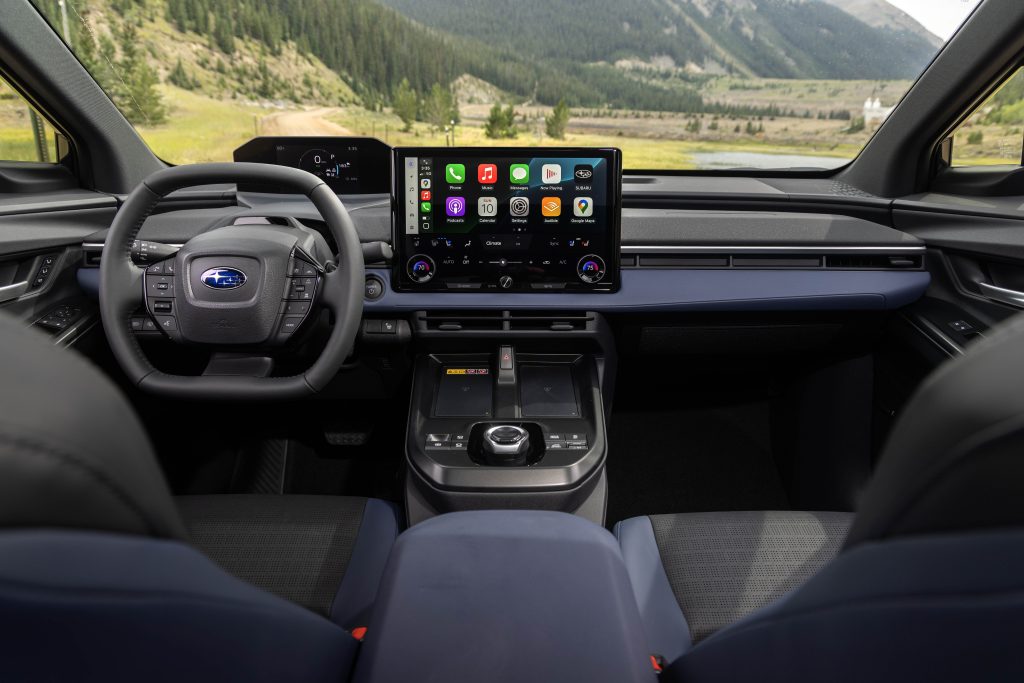
The original cabin of the Solterra and bZ4X was roomy and comfortable enough, but frankly it had some significant usability issues. The center console was both tall and wide and felt a bit intrusive. The infotainment system which is Toyota’s latest was fine with its 12.3 inch touchscreen. However, most of the controls were touch below the display with nearly flush pushbuttons for the volume and small rockers for temperature and fan speed.
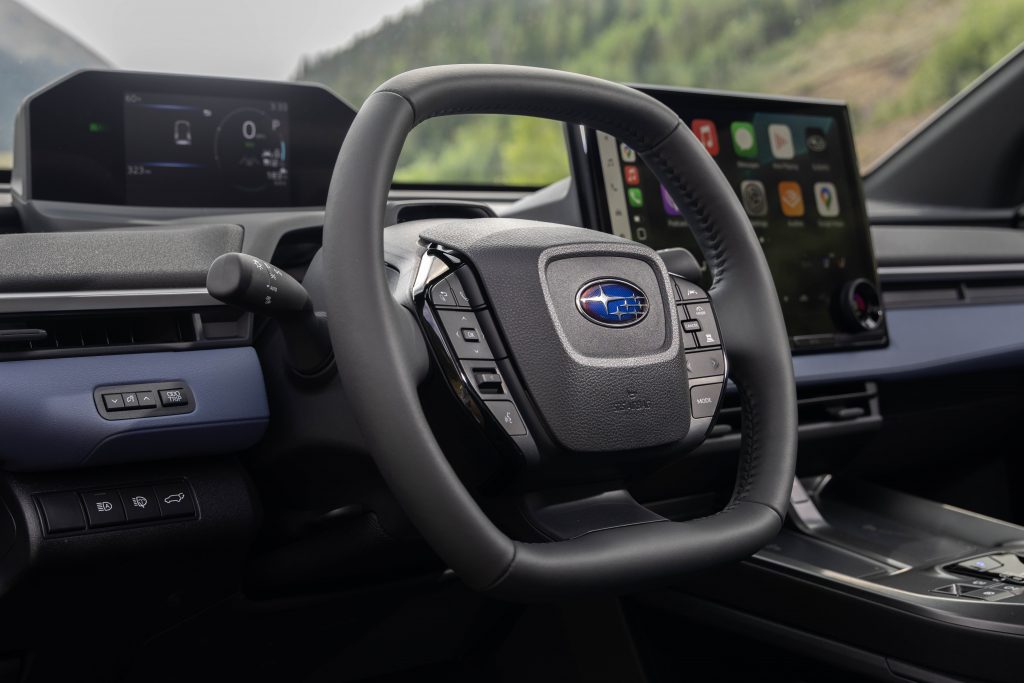
The touchscreen has now grown to 14-inches but there are three rotary knobs to control volume and temperature on each side. The console is now lower and narrower and instead of the single wireless charging pad below a translucent flip up cover, there are now two pads at the forward end of the console. The shift controller is the same as before, twist right for drive, left for reverse and push the button for park, but it has been moved back behind the charging pads.
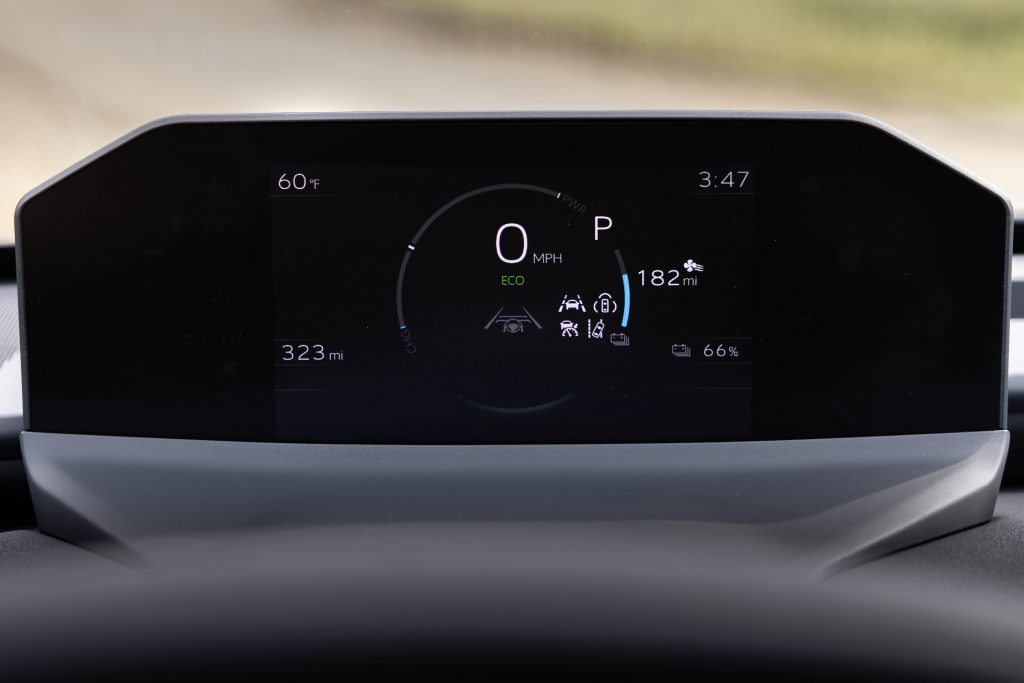
However, the biggest cabin issue was the instrument cluster. The 7-inch display was mounted up near the base of the windshield at the end of a tapering sort of valley. The idea was to provide something akin to a heads up display so the driver didn’t need to look down away from the road as much. The problem is it was mounted a bit too low and almost everyone that drove these vehicles found that when the steering wheel was properly positioned, the top of the wheel cut off the bottom half of the display.
For 2026, the valley is gone and the same display is mounted a bit higher up. Subaru has also opted for a steering wheel with flattened top to try to ensure that the display isn’t blocked. Toyota has retained a round wheel and when I tried it out a few months ago, it was fine and I didn’t find the display blocked in either car.
On And Off Road
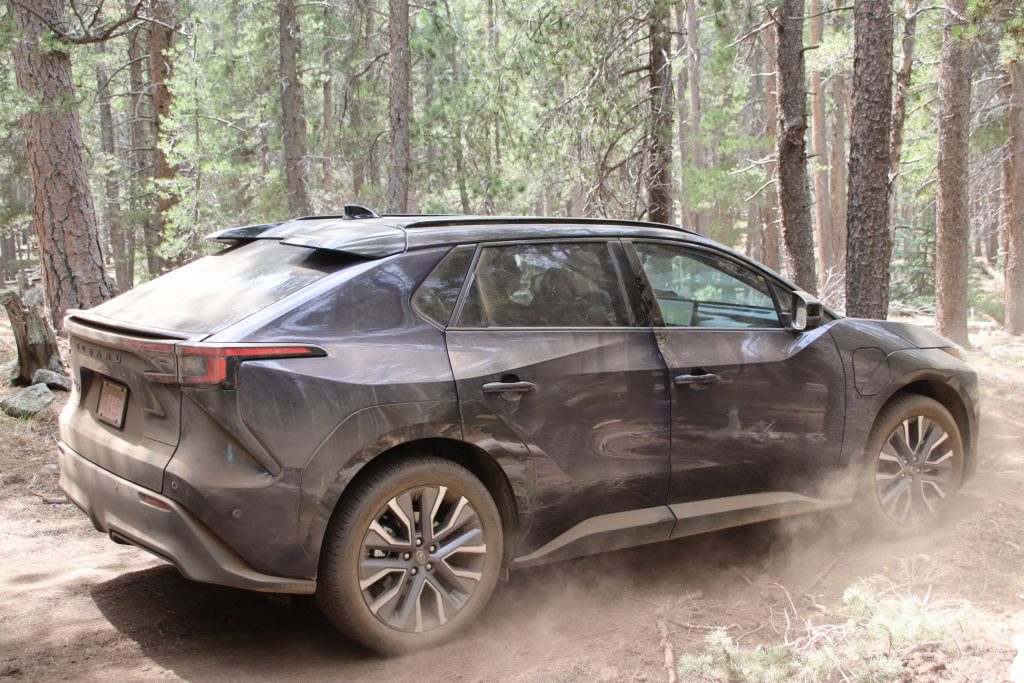
No one will argue that the Subaru Solterra and Toyota bZ are the same car with the same capabilities and only the most subtle of styling differences. Toyota and Subaru openly acknowledge that they collaborated on engineering and building them. But both companies feel like they have very different customer bases and when they invite us somewhere to drive the vehicles, the experience is dramatically different.
In 2022, when they launched, Toyota brought us to Encinitas to drive the bZ4X on roads between there and Carlsbad. All the drive routes were on pavement with the closest we got to going off road was if we stopped at a beach for some photography. Around the same time, Subaru took media to Santa Barbara for on road drives and then popped over to Catalina island to go off-road.

This year, we got a short preview of the bZ on the roads near Toyota’s Plano, Texas headquarters. Subaru on the other hand brought us to Denver, Colorado. From Denver we quickly moved up into the Rocky Mountains with a route that was a surprisingly equal split between pavement and dirt roads of extremely variable quality. Toyota targets the same suburban families and city dwellers that buy Rav4s and Highlanders. Subaru knows a significant portion of its customers live more active lifestyles and while they may not regularly tackle Moab or the Rubicon Trail, they are heading to remote campsites and hiking trails.
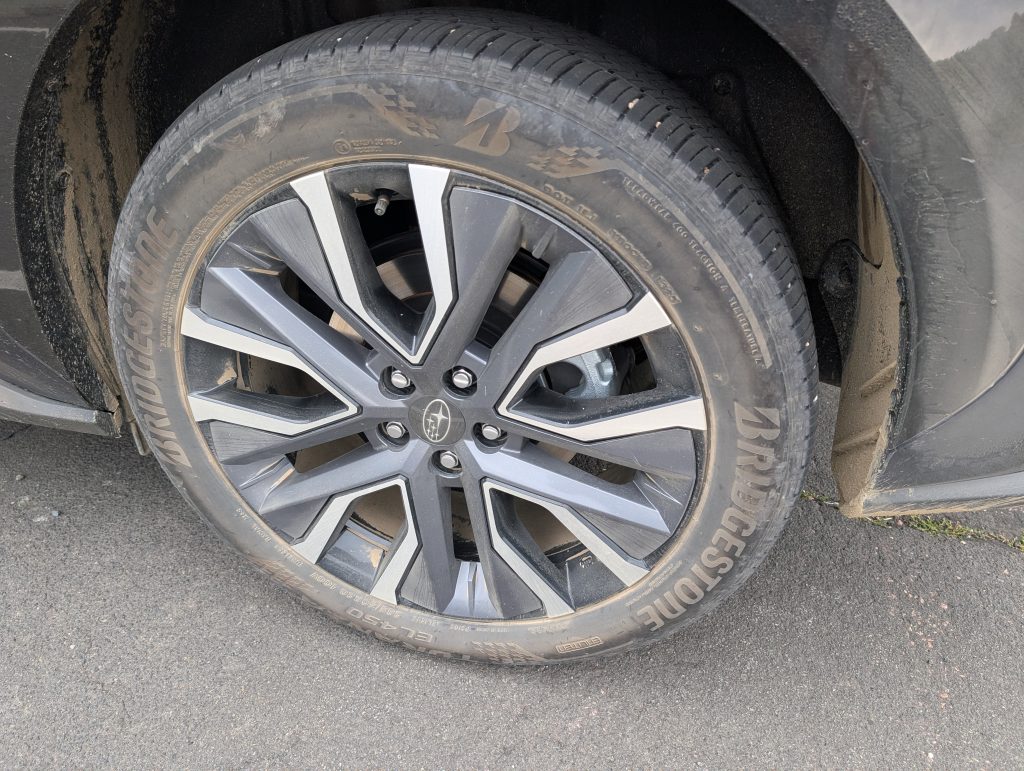
My drive partner and I selected Solterra Touring XT trim equipped with the optional 20-inch wheels and Bridgestone Turanza all-season tires. This is not a combination that’s going to compete with all-terrain BF Goodrich K03s or Goodyear Wranglers on those aforementioned trails. Despite that, Subaru had no reluctance to send us to places that were surprisingly challenging without cheating by installing non-factory tires. Even with its more authentic off-road vehicles, Toyota is sometimes reluctant to get into the really tough terrain. Bravo for Subaru in standing behind what they sell.
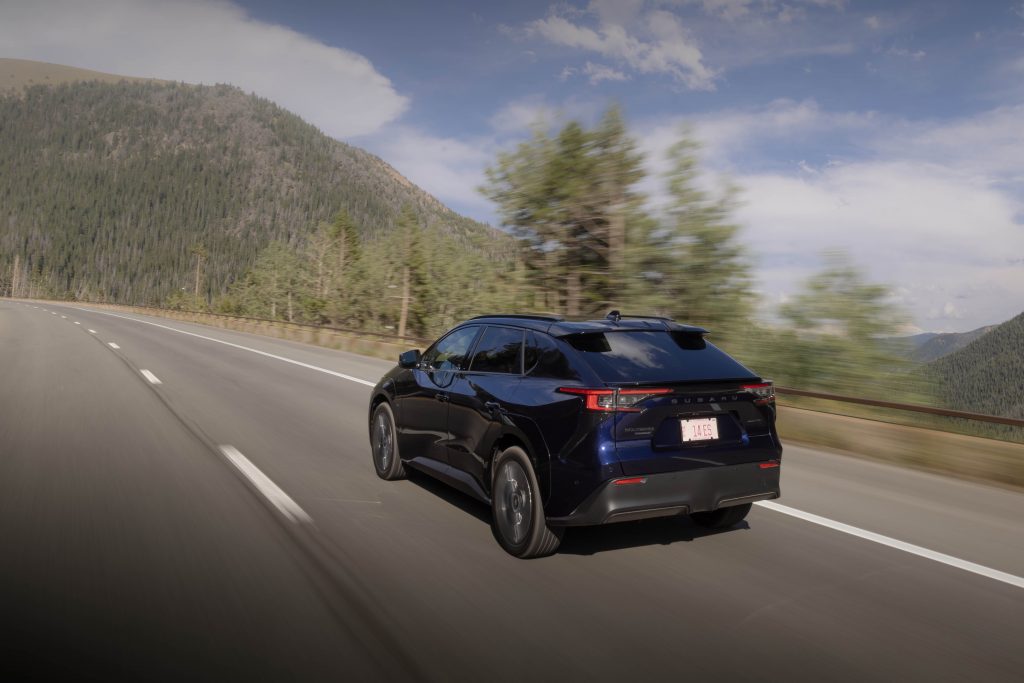
As we headed out of Denver, one thing became immediately clear: All of the work on the structure, suspension, aero and insulation paid off. There was almost no noticeable wind noise at highway speeds and road noise was commendably modest even on some coarser pavement. The Solterra was very comfortable to ride in as a passenger and to operate from behind the wheel.
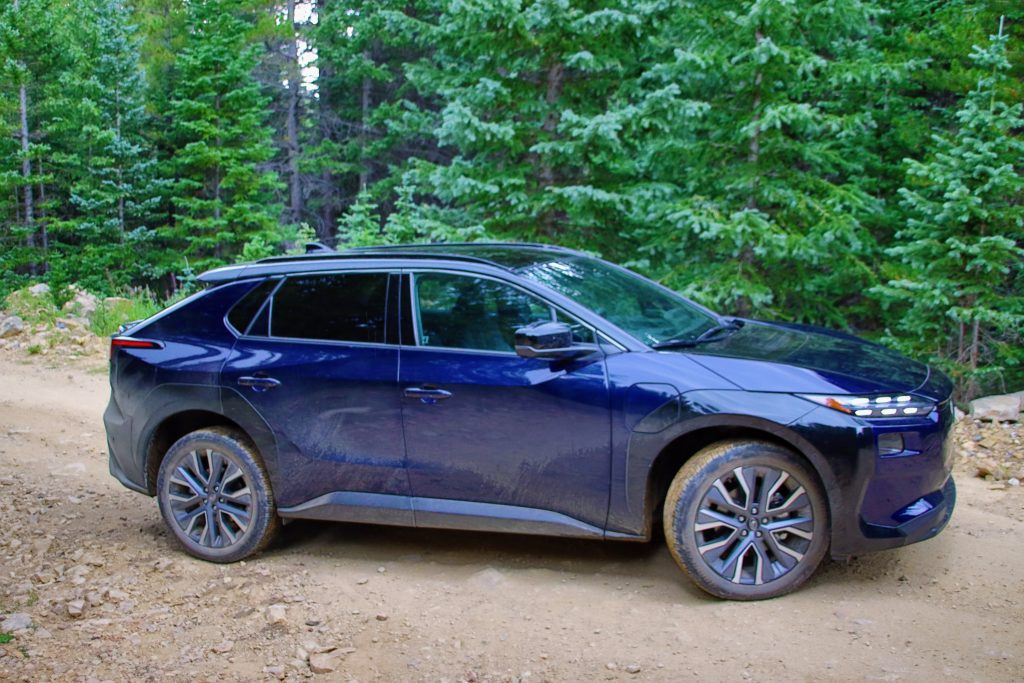
As we climbed up from Denver’s 5,280 ft elevation to 7,000 ft and beyond we eventually left the paved surfaces and moved onto dirt. Internal combustion engines need oxygen to mix with fuel in order to produce power and torque. As you get beyond one mile above sea level, the atmospheric pressure and oxygen concentration gets progressively lower.
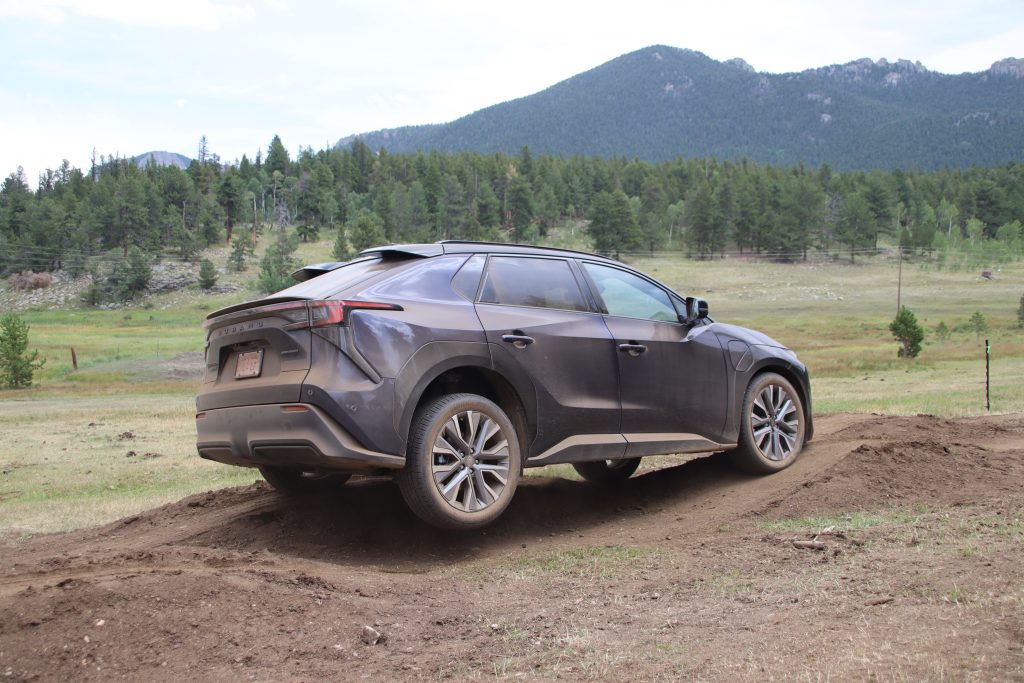
If you ever watched any of the videos on the TFL Youtube channels, you’ll have seen just how much performance an internal combustion engine loses at these elevations. An EV on the other hand doesn’t care if you are in Death Valley or on Mount Everest, the performance is the same (well at least to the degree that extreme hot or cold affects the battery). The human operators have more difficulty when you go to these elevations than the EVs do so Subaru put a few cans of oxygen in each car along with water bottles if we need them.
The roads we were on were twisting mountain roads with very steep walls going up on one side and dropoffs on the other and no guardrails to be found anywhere. We eventually climbed to over 9,500 ft before starting our descent to our first break stop at about 7,500 feet. There I asked the Subaru representatives if they were planning a Wilderness edition of the Solterra as they do with other models that have all-terrain tires. The answer was no, because that is effectively going to be the role of the Trailseeker that is coming early in 2026. The Trailseeker (and Toyota bZ Woodland) is a wagon version of the Solterra with a longer roof, but otherwise the same footprint and it can be thought of as an electric Outback.
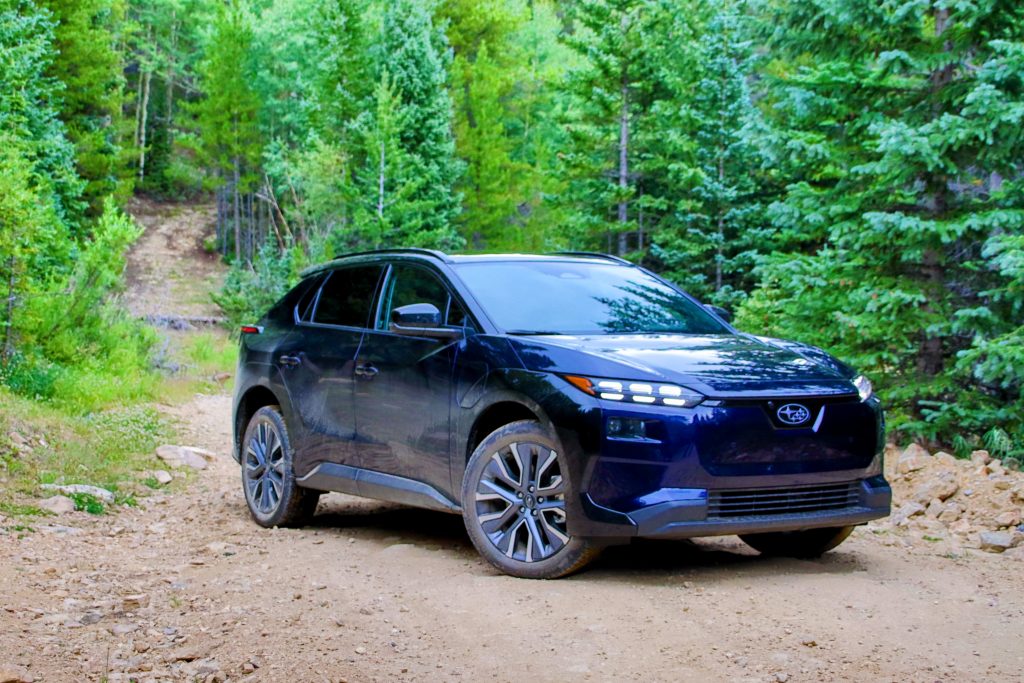
The Solterra had no issues at all climbing these mountains even when traction was reduced. This is clearly a testament to two factors. The engineers have done an admirable job on making the response of the motors to accelerator and brake input as smooth and predictable as possible. What you don’t want on these loose surfaces is the output suddenly increasing when there’s nothing around to keep the car on what passes for a road. The other is a very capable stability control system that again manages the output and brakes seamlessly to keep anything from getting out of hand.
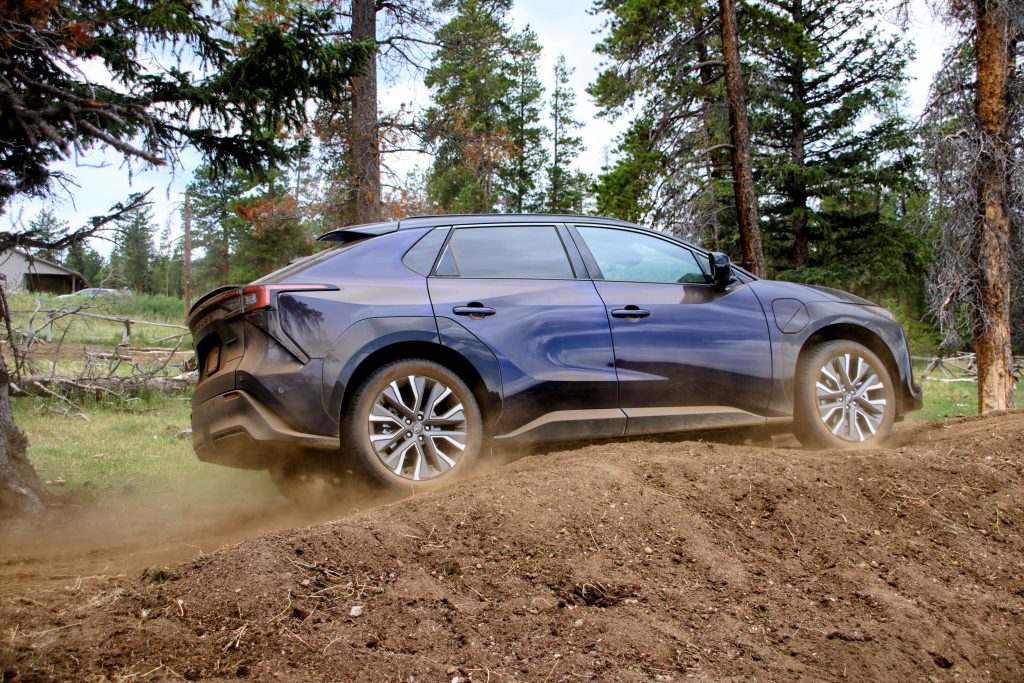
When we got to Rudolph Ranch in Black Hawk, we did some off-roading. Other automakers would have their specialized off-road variants reserved for these courses with other trims parked and reserved for the street. Not Subaru; we just continued with the same cars we had been in for the last several hours right onto the course. We engaged X-Mode for hill descent control on a steep downhill and apart from hearing the brake hydraulic actuator grinding away to keep the wheels under control, it was uneventful.
Over some fairly large dirt moguls, even the limited articulation didn’t cause the Solterra any real difficulty. The traction control kicked in quickly to lock the wheels that were airborne so that those on the dirt could keep going. This was on fairly horizontal terrain, so we couldn’t judge how it would do if it had to climb against gravity, but given the street tires we were on, it did shockingly well. Climbing up a relatively steep, but flattish portion of the course, the grip enhancement mode again helped direct motor torque where it would do the most good.
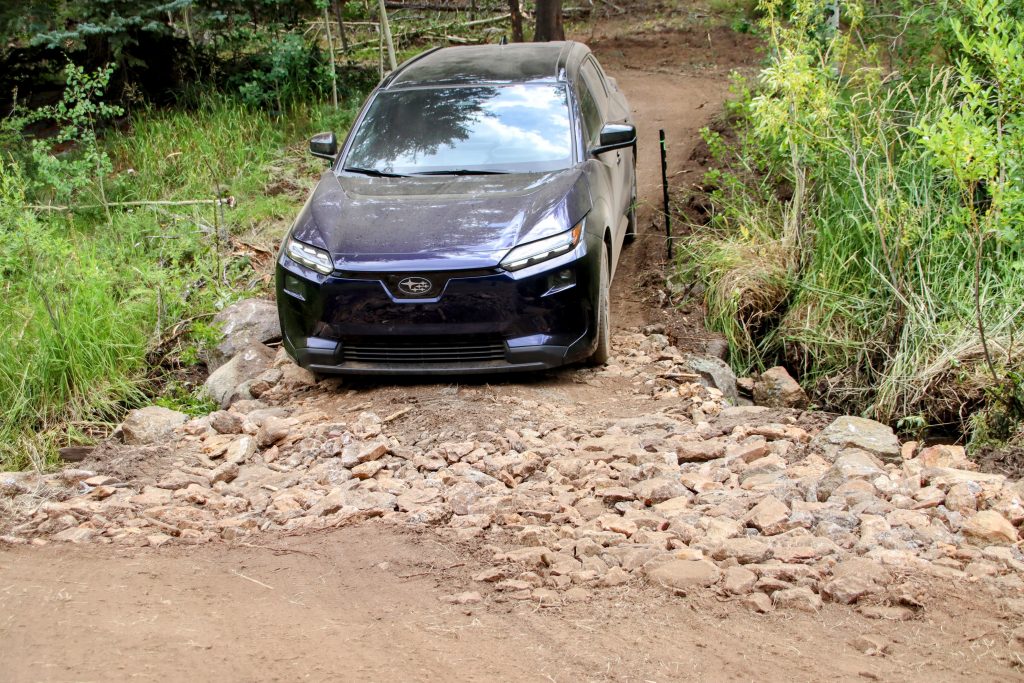
Through a heavily wooded section, the relatively modest width of the Solterra made it far more maneuverable than something that would be considered a pure off-roader like a Bronco. Toyota’s events team should really have a chat with their counterparts at Subaru about planning drive routes for the bZ because a lot of people would be surprised at how capable it actually is.
After lunch in Nederland, we headed back in the general direction of Denver with one particular stretch along a road called Gamble Gulch. On the route card, the instructions said at 8.2-miles, be cautious of the rocks. It turned out that on this particular stretch, there were some quite prominent rocks poking up through the dirt. Contrary to most of the other electric crossovers on the market including some “off-road” oriented variants, the Solterra (and the bZ) have 8.3-inches of ground clearance. For comparison the Hyundai Ioniq 5 XRT only has 7-inches and the Ford Mustang Mach-E Rally has a mere 5.8-inches.
While 8.3-inches isn’t going to go very far on the Rubicon Trail, it had no issue at all with the protrusions on Gamble Gulch. The biggest risk we actually faced was avoiding hitting the low profile sidewalls on some of the sharper edges. This is why true off-roaders don’t use massive wheels. Instead they typically don’t go over about 17-inches with the wheels and rely on tires with tall sidewalls and lots of compliance. As with most EVs, the Solterra doesn’t have a spare tire and the tire mobility kit is only designed to seal punctures from nails and screws, not cut sidewalls. Fortunately, Subaru had support vehicles following behind with some spares if needed, but we got through without issue.
When we did stop to do some photography, I did end up taking a few hits from the oxygen can after clambering up and down the hill a few times and it certainly helped.
Some sections of the dirt roads had pretty substantial washboards and bumps and here the work that Subaru did on the vehicle structure and suspension really paid off. While it certainly wasn’t Rolls-Royce Spectre smooth, the Solterra was surprisingly well controlled and compliant. Even on the roughest sections, we didn’t really get any significant head toss and we ended up hearing the roughness through the wheels and suspension more than we felt it on our backsides. I’ve driven off-road vehicles with a lot more suspension travel than this had us bouncing side to side a lot more.
Curving dirt roads through the mountains require more modest speeds than what you would do on pavement so steering feedback isn’t going to be as prominent. Nonetheless, the steering was precise and between the mechanical grip and electronic aids, it was fairly easy to place the Solterra exactly where you wanted it and have it stay there as long as you didn’t overdo it trying to corner on dirt.

Once we got back onto pavement, the new steering setup actually felt quite good. While a Solterra isn’t likely to challenge a BRZ on the track, the low center of gravity from the battery absolutely helps the driving dynamics. As speeds increase, there is a bit more body roll, but nothing alarming. We didn’t do any formal timing, but on a couple of quick sprints it definitely felt like Subaru’s claim of 0-60 mph in 4.9 seconds was utterly plausible.
But the updated Solterra isn’t perfect. It does retain one aspect of the original that I didn’t care and that is the regenerative braking behavior. There are steering wheel paddles that allow you adjust the amount of regen at will, but even in its most aggressive setting, this vehicle isn’t really capable of one-pedal driving. The max regen isn’t strong enough for most typical driving without using the brake pedal and this was apparently at Toyota’s insistence. The bigger partner in this relationship felt most buyers of the bZ in particular will be transitioning from other models in the lineup like the Rav4 and wanted customers to have a familiar experience. I personally don’t buy this argument. I think it’s fine to default to a light regen mode that coasts like an ICE vehicle, but offer the option in the settings to enable one-pedal mode like other manufacturers do. After all, it’s all controlled in software anyway.
Listening and Attention to Detail Works
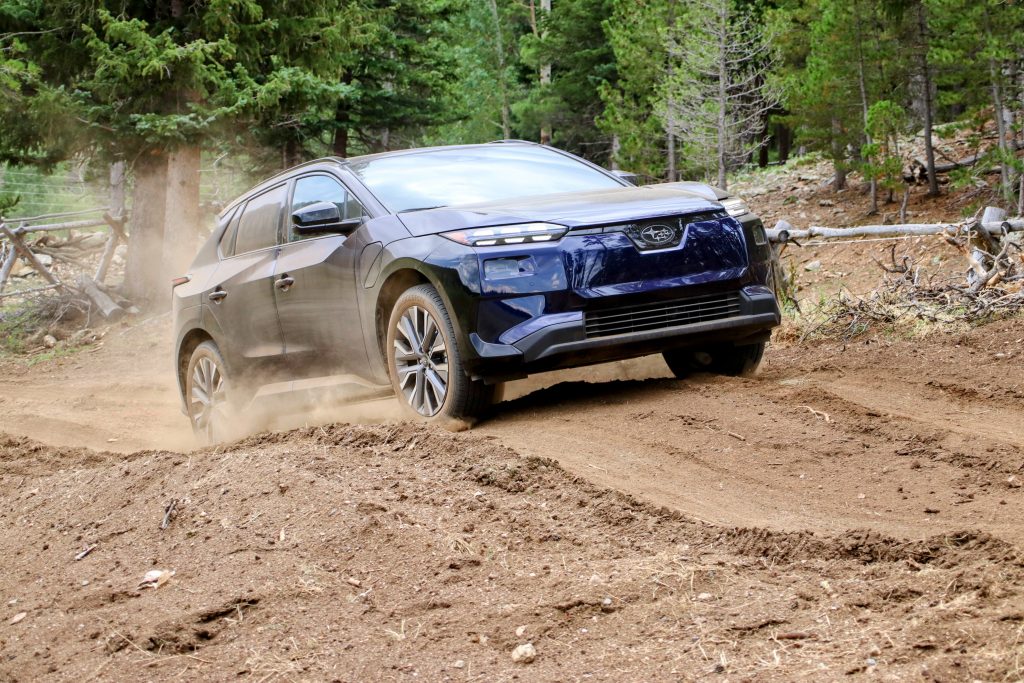
I like many others was severely underwhelmed by the Solterra and bZ4X when they launched. They had mediocre range, ridiculously slow charging, rather high prices, ergonomic issues and weren’t pretty. But Subaru and Toyota have listened. Since launch, they have fixed pretty much everything about these vehicles. In 2022, I absolutely wouldn’t have recommended this vehicle.
That’s no longer the case. Unlike the Toyota which can be had with front wheel drive, the Solterra is always all-wheel-drive. With AWD and the 18-inch wheels, it now has a range of 288-miles while the 20-inch wheels take 10 miles off of that. During our drive, on the first segment which involved a lot of climbing to over 9,500 ft, the Solterra averaged a respectable 3.3 miles per kWh which would work out to just over 246 miles. On more level terrain, the EPA range numbers would probably be totally realistic if not a bit conservative. While charging isn’t as good as an Ioniq 5 or EV6, it too is now reasonable and the preconditioning means you can do it all year round.
Even on all-season street tires, the Solterra will get you easily to a trailhead or remote campsite in the woods. It will accomplish what Subaru owners expect of any Subaru. We don’t have official pricing just yet, but Subaru tells us the price changes will be less than $100 from the 2025 models despite being built in Japan and subject to tariffs. The 2025 Solterra Premium went for $40,390 including delivery. The ‘25 Solterra Touring went for $46,890.
I can’t wait to see where Subaru sends us to try out the Trailseeker.
Images: Subaru or Author

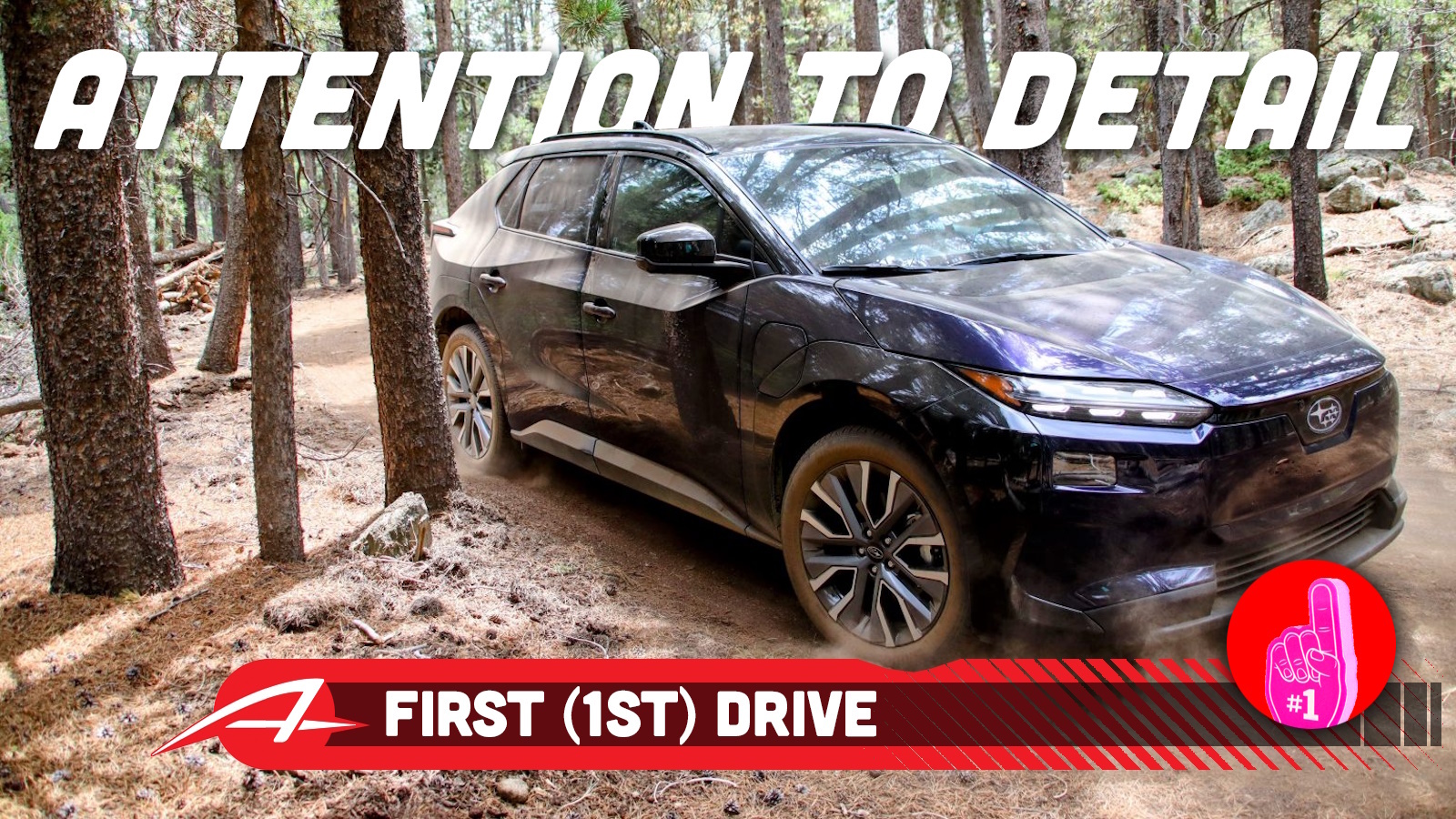




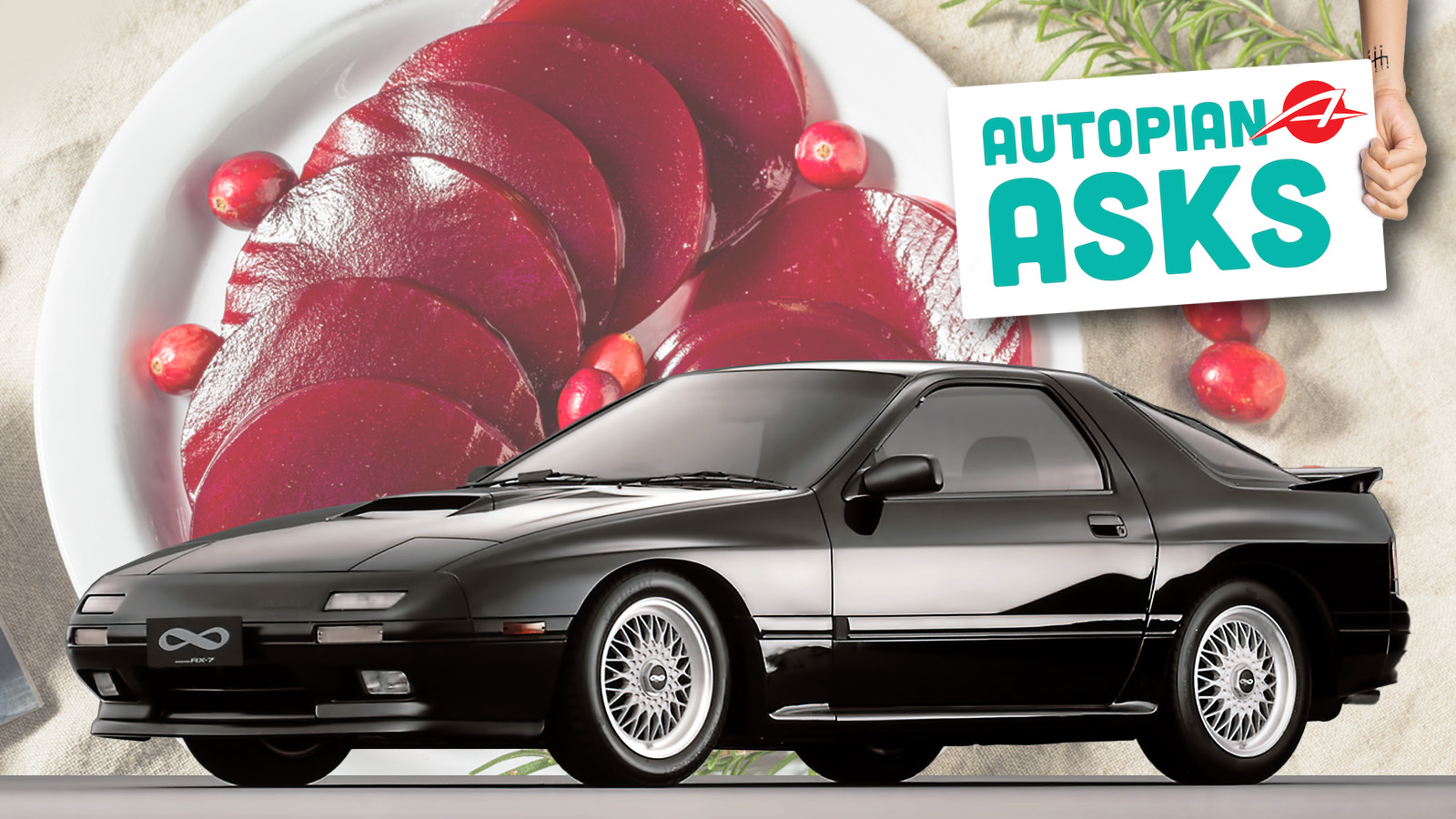

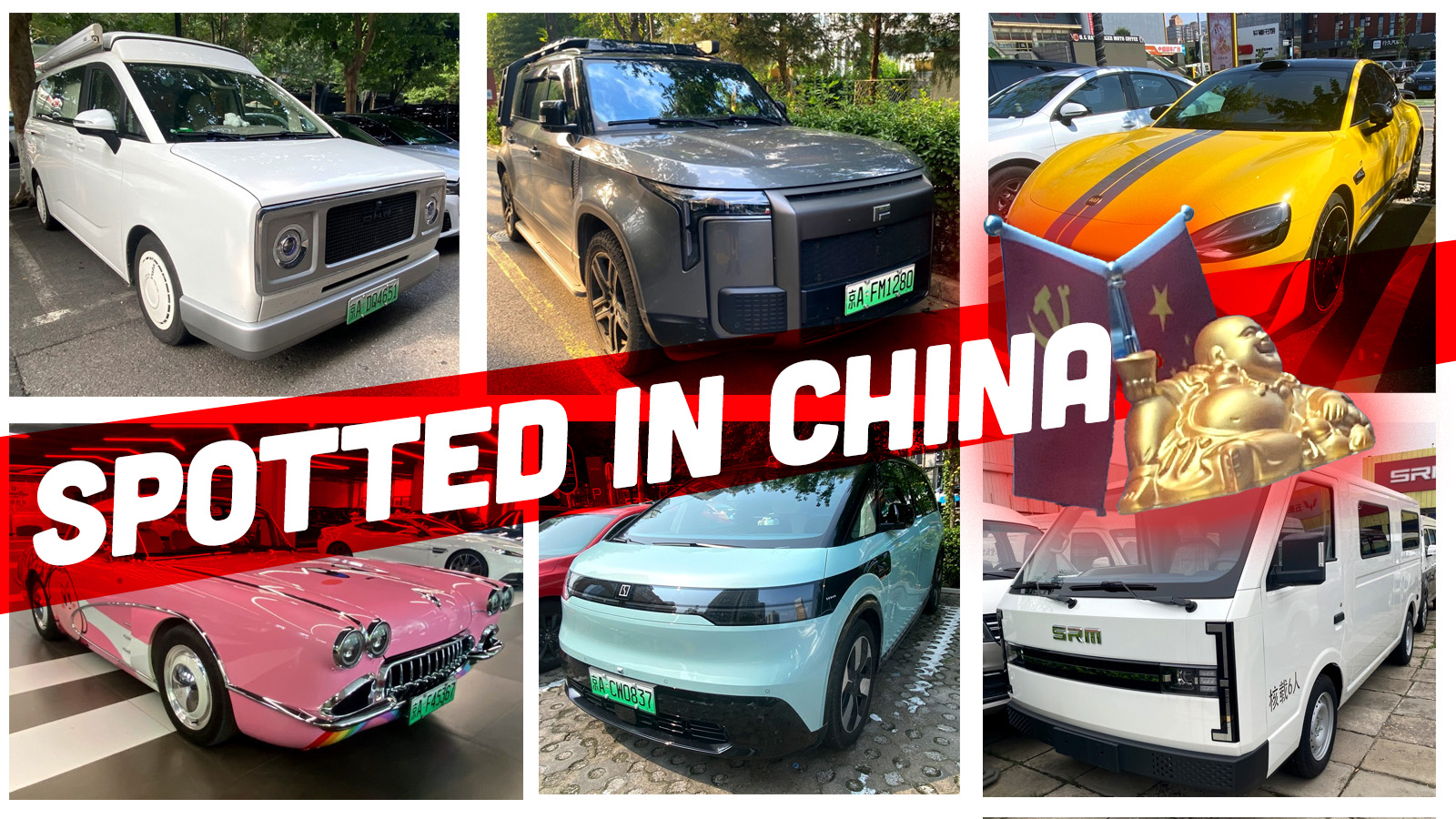
> Unfortunately, the body colored arches are only available for customers who select white, silver or black for the sheetmetal paint. The other colors, mist gray pearl, elemental white and the new midnight tide mica retain the black arches.
This is a baffling move. No, Subaru, I’m not going to buy *anything* with that hideous black plastic cladding. What are you thinking?
The upcoming Subaru EV vehicles are actually making me interested in Subaru again. I’d pretty much written off Subaru as a replacement for my 2015 Forester – no more turbo Forester, I don’t like the current exterior aesthetics, and I hate the updated interiors with that massive screen. And then there is the new Outback which I neither like nor understand.
The EV models have a much cleaner dash, better exteriors, 375 HP sounds pretty good and no CVT on an EV! Hopefully there is a decent amount of window glass – one of my favorite aspects of the Forester – the Trailseeker looks very promising.
I’m so happy to pay for this membership when it returns detailed analytical reporting on a model revision such as delivered here by Sam. Keep it up!
Correction on the astronomy: the Pleiades are by official mythology the seven sisters. Most normal humans can see six of those on an average dark night, not just five, with the seventh visible if conditions are right and you have a really dark sky. (It’s harder for me at nearly 50 than it was when I was younger…)
The star cluster itself contains over a thousand stars – they are close in actual space, not just our perspective like most constellations.
The 5-into-1 origin of Subaru is correct, but not the asterism the company borrowed for its name and logo.
Thanks for this Timothy… I’d heard of the seven sisters and was always a bit confused as to why there aren’t seven stars in the Subaru logo. 🙂
Big win in the most improved category. Too bad ev sales are gonna fall off a cliff when the incentives end.
That sounds like a good and wonderful thing.
I get retooling is expensive…..but why did they leave the stupid splat-shaped tail lights alone. A stretch to refer to them as tail lights since the lower thingy doesn’t even contain lights, but man did they need to just ditch that lower chunk of plastic light cover and fill the area with the body panel.
Gotta maintain the Toyota fangs, ugly and useless things.
A friend of a friend recently got a new Toyota BZ4X which is the same (just about) as the Subaru Solterra. It’s not awful, and might actually be worth buying/leasing if you want a decently sized EV at a good price (I gather these are often discounted due to mediocre reviews, the polarizing looks, and the problems it suffered on initial release). It’s definitely not a pretty car, and it doesn’t excel in any particular area vs. its rivals, but a mediocre Toyota or Subaru is still probably a pretty decent car if you only need a point-to-point appliance. JMHO.
Kudos to Toyota/Subaru for directly addressing customer complaints. I wish they’d also have tweaked the regen system to allow for one-pedal driving, which is possible on most other EVs. Maybe they’ll do so with a software update at some point? I think the dark blue with the black fenders looks pretty good for what’s still not a particularly attractive car, though the diamond-cut grey-painted wheels so common to lots of crossovers these days look too busy and even a bit ugly.
Still, at a good discount, I’d think the revised BZ4X/Solterra would be worth considering, though I’d probably rather have the Hyundai Ionic 5 instead, which I really like. 🙂
Thanks for the review Sam! 🙂
I like the old front end more than the new.
“Subaru put a few cans of oxygen in each car along with water bottles if we need them.”
Was it Perri-Air and Perrier?
Oops, I didn’t read far enough in the comments. Credit to V10 for a similar Spaceballs reference.
Still a very odd design for something advertised as off-road-ready, maybe more so without the cladding. Hard to see dents adding character to this look.
Seems like enough time on the road-less-traveled would result in thousands of dollars worth of bodywork.
The front end now looks like one of those RAV4 compliance EVs
I prefer the black contrasts, because it’s kinda generic without them, but wish they were matte gray or black ABS, like the Honda Element.
No, bad!
The Solterra/Bz is now almost attractive with just enough range and charging capability to convince a decent number of affluent early/mid majority-type brand loyalist consumers to take the EV plunge. The dash layout is still hideous which is what’s to be expected from the marriage of two legacy automakers known for largely eschewing visual appeal.
Were they using really bad wheel bearings and a dry gearbox before? The driveline changes make it sound like they completely forgot how to build cars when they started designing.
Yeah those are crazy improvements out of really not that much, would make me wonder if the bearings can be retrofit to the last-gen model…
Looked up a service manual for the current generation and it looks like it’s just a standard bolt-on bearing assembly like you find in a wide range of cars. I too would like to know what they changed and how it works.
Probably more likely they were cheaping out on the first run, not expecting the competition to put out their best efforts, either. Then when the cars are panned for being so uncompetitive, they course corrected as much as they could within the confines of cost and the current platform.
I can’t wait until all the Subaru models converge on the exact same build but with different nameplates.
Would make more sense to have a single line with several different body styles – such as the Leone:
3 door hatch
4 door sedan
2 door hardtop coupe
5 door wagon
2 door coupe utility
lmao the front end looks worse
Agreed. The front end looked pretty good, all that was needed was the tweak to the damned wheel arches.
Makes me wonder how long that’ll last, and how many ‘temporary’ tweaks that automakers do to vehicles to achieve specific numbers.
Wouldn’t this apply to all cars? I’ve never heard of this. If you go with after market bearings on a WRX will you get better gas mileage? 18% seems huge for something that should have been figured out 80 years ago
Exactly, this seems the kind of marketing a wheel bearing company might quickly advertise if it were true/long-lived (or, for many companies, even if it’s not true) regardless if it’s EV/ICE.
Just put in 18% fewer rollers and you get 18% less drag.
My first thought too.
It’s either BS, or they’re not as durable.
I’d assume it’s mostly something like surface finish, bearing materials and hardness, precision/clearances, lubrication type, and size. I’d expect more of a cost tradeoff than a durability one, though 18% feels like a big difference unless they were really cheaping out with the original design.
A more efficient bearing can be much more durable, similar, or much less durable. Harder, smoother surfaces that wear slower are more efficient. Having fewer load bearing surfaces is also more efficient, but each wears out faster.
Hard to say which direction they took without looking inside both the old and the new.
I so dislike that most passenger cars don’t have a spare tire and instead have that stupid can of air+glue, it seems really dumb to have something that markets itself as being off road capable (even if it will never go there) and STILL won’t include a damn spare tire.
I’m sure the automakers would argue that it effects range/fuel consumption, but I’m betting that it’s just a way to cheap out.
I think only Ford and some Volvos still have spares. Yes, last auto show I was at, I checked under the trunk mat of just about every car in there. I’m that guy.
It used to even be something that automakers would list within their brochure to tell you that it’s either a space-saving-spare, or a full-size-spare.
Now rarely is the repair kit, nor the tire is noted even when it’s included.
Hope you’ve got phone coverage if something happens.
I don’t agree with this trend either as my donut spares had gotten me out of sticky situations multiple times. Unfortunately automakers may have rightfully determined most owners are no longer willing or able to use the donut spare even if it was there and would call for roadside assistance regardless.
I’m curious as to the stats of how often the inflator+goo is actually useful. Of the three times I’ve had a flat tire, only one of them was a failure that the sealant would have been able to help with.
I ended up buying a third party spare and taking the hit to cargo capacity– I do enough driving where cell service is marginal and AAA would at best take hours.
Toyota still uses donut spares on several of their cars
For real, Subaru? I’m not sure which is worse: that that is the truth or that that is the lie they came up with.
The lie is so much worse, and so unnecessary.
Just, like, why??
The black arches are, broadly, not good looking.
Great idea to be able to get rid of that look.
But only certain ones!
I’ve not seen pricing on paint options yet, but I betcha the painted arch colors are the biggest upcharge!
Reminds me of the VW Buzz – oh, you want the paint that pretty much anyone would go for? Yeah that’s an extra $1500.
Most manufacturers paint their plastic bumpers
Same can be done for wheel arches – or golly, just make the fenders one piece.
It’s not difficult people.
What!!??
I can’t be the only one who immediately thought of President Skroob huffing Perri Air at his desk.
You’re not…
probably this: https://www.boostoxygen.com/
Again feels unnecessarily manipulative – is this SOP for car journalists drives at altitude? Or just some genius who decided that it was a clever way to point out that EVs don’t burn air?
Altitude sickness is a real thing, and a hit of O2 can really help your day out if you’re a coastal-dwelling pudgy autojournalist suddently finding themselves walking around at 7 or 8K feet without any time to acclimate. Probably a wise move by Subaru to (a) keep the writers happy and (b) maybe keep a light-headed writer from damaging the demo vehicles.
Watch the sidelines of the opposing team whenever you see a Broncos home game televised – a good chunk of those players are huffing on oxygen masks between series, and those are well-conditioned athletes.
I got to drive through the Eisenhower tunnel earlier this year for the first time (just after flying into DEN, so it was a long travel day before I even started West on 70!). Normal elevation for me is just under 1,000′, so being above 11,000′ for the first time was wild. I was in awe of the whole thing, and suddenly noticed as I was on my way down (toward Silverthorne) that just steering and breaking were work, and I was breathing much more heavily than I “should” have been for driving.
As much as I laugh at the idea of “cans of oxygen”, I understand the need for people not used to it!
For automotive interest: that’s also a stretch of road where auto manufacturers test their tow ratings and where I spend altogether too much time wondering if that tow vehicle REALLY has enough brakes to handle that much trailer barreling down the hill behind it.
That specific stretch of road makes me more nervous than anything else in Colorado.
I went to the top of Mauna Kea in Hawaii a number of years ago; going from sea level to nearly 14k feet in a short time threw me off BIG TIME. I was in relatively good shape at the time, but hadn’t been over 5k feet in my life. It’s pretty wild if you’re not used to it.
I think it was smart, both for practical reasons, and to give those driving the car the impression that they were indeed taking this vehicle to a place extreme enough that they may need a can of oxygen. Excessive, maybe, but understandable.
Yeah, I might not have been clear enough, I was surprised that there was such a thing as “canned oxygen”, not that Subaru would take measures for drivers at elevation.
I too was surprised, laughed, and then was like “yeah ok”.
An actual oxygen mask (and presumably a big tank or an actual plugged-in concentrator) is a very different thing, though. The Boost cans are pretty small and low-pressure, and won’t last very long. I think there’s a lack of any real evidence that it makes any difference in altitude sickness.
I’ve been on press trips where O2 was on hand and press trips where there wasn’t any. There didn’t seem to be any real rhyme or reason other than what the organizers were thinking. I would have been delighted if there had been some oxygen available on my snowmobile press trip, which took place between 10,000 feet and 12,000 feet. I got absolutely destroyed by altitude on that trip and would have appreciated it.
Thanks for the insight!
Came here for this.
Definitely the first thought that popped into my old noggin